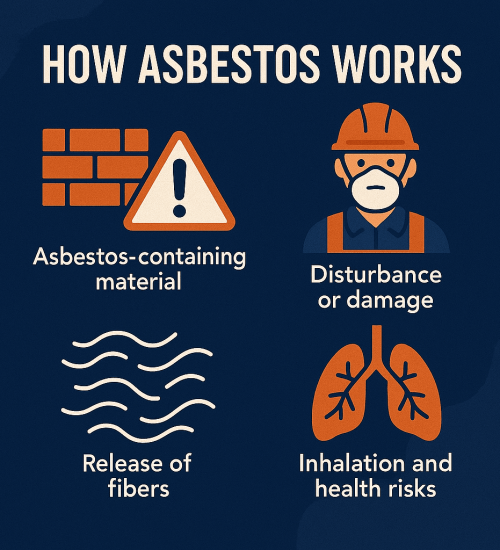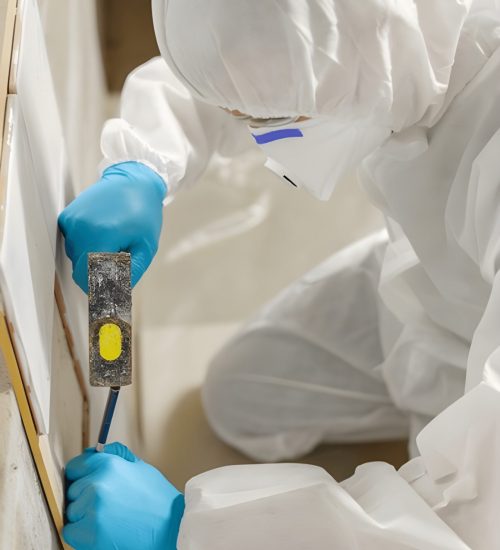- Booking is simple! Contact us via phone, email, or our website to schedule your survey at a time that suits you.
//
Don’t hestitate to contact
Let’s book your appointment online


What is an asbestos survey?
An asbestos survey is a critical diagnostic inspection designed to detect the presence of asbestos-containing materials (ACMs) within a property. Required under the Control of Asbestos Regulations 2012, this survey is essential before any demolition, refurbishment, or significant maintenance work. It identifies whether asbestos is present, its location, type, and condition, and provides the foundation for a safe asbestos management or removal plan.
At Landlord Certify, our qualified surveyors use industry-standard techniques, including sample testing and area mapping, to deliver a clear and actionable report. This ensures duty holders can manage risks effectively, comply with legal requirements, and protect occupants from potential harm.
Key features of our asbestos surveys:
- Identifies both hidden and visible ACMs
- Ensures full legal compliance and reduces liability
- Provides detailed findings with photographic evidence
- Conducted by UKAS-accredited asbestos surveyors
Why is asbestos surveying necessary?
Asbestos, once widely used in construction for its heat resistance and durability, is now recognized as a silent but deadly material. Despite being banned, many residential, commercial, and industrial properties still contain asbestos-containing materials (ACMs). When disturbed, these materials release microscopic fibers into the air, which can be inhaled and cause severe health issues.
- Health risks of asbestos exposure:
- Mesothelioma: A rare and aggressive cancer affecting the lining of the lungs.
- Asbestosis: Chronic lung disease caused by inhaling asbestos fibers.
- Lung Cancer: Long-term exposure significantly increases the risk.
These conditions often remain undetected for years, making preventive measures essential. By identifying and managing ACMs early, an asbestos survey helps reduce the risk of accidental exposure during routine maintenance or major renovations.
- Legal compliance and duty of care
Conducting a professional asbestos survey ensures compliance with the Control of Asbestos Regulations 2012 and other UK legal requirements. It’s not just about ticking a compliance box—it’s about demonstrating your duty of care to protect staff, residents, contractors, and visitors from harm.
- Benefits of regular asbestos surveys:
- Prevent costly legal claims and project delays.
- Ensure smooth property transactions with proper documentation.
- Gain peace of mind knowing your building is safe and compliant.



How the asbestos survey process works
At Landlord Certify, we follow a structured process to ensure accuracy and compliance:
- Step 1: Initial consultation
We begin with a consultation to understand your specific needs. Whether you require a Management Survey for ongoing property use or a Refurbishment & Demolition Survey before construction, we recommend the most appropriate survey type based on your property’s age, layout, and usage.
- Step 2: Site visit
Our certified surveyors conduct a thorough inspection of your premises, visually identifying potential ACMs and safely collecting representative samples.
- Step 3: Laboratory analysis
All samples are sent to UKAS-accredited laboratories for precise analysis to determine asbestos presence and type.
- Step 4: Detailed reporting
We compile a comprehensive report that includes:
- A floor plan highlighting asbestos locations.
- Material conditions and associated risk ratings.
- Photographic evidence and tailored recommendations for management or removal.
- Step 5: Action plan
If asbestos is present, we assist in developing a management or removal plan, connecting you with licensed asbestos removal contractors if necessary.
Why Choose a Landlord Certifiy for Your Asbestos Survey?
- Certified professionals
Our surveys are conducted by UKAS-certified asbestos surveyors with extensive experience in residential and commercial properties.
- Detailed reporting
We provide clear, easy-to-read reports with photographic evidence and a comprehensive risk register.
- Fast turnaround
Most reports are delivered within 48 hours, with emergency appointments available upon request.
Asbestos survey pricing
Residential Survey
- Ideal for homes, flats, and small properties.
- Includes visual inspection and sample collection.
- Detailed PDF report delivered within 48 hours.
- Covers up to 3 rooms.
Commercial Survey
- Suitable for offices, shops, and warehouses.
- Includes risk assessment and ensures legal compliance.
- Emergency call-outs available.
- Pricing varies based on property size.
Additional Charges
- Parking Charges (if no free parking is available).
- Congestion Zone Surcharge.
- Additional Rooms: £20/room.
- Express Reporting: £30 extra.
Frequently Asked Questions (FAQs)
- An asbestos survey identifies the presence, location, and condition of asbestos-containing materials (ACMs) in a property. It’s essential for compliance with the Control of Asbestos Regulations 2012.
- Surveys are required before demolition, refurbishment, or significant maintenance work. Regular surveys are also recommended for ongoing property management.
- The two main types are:
- Management Survey: For routine property use.
- Refurbishment & Demolition Survey: Required before construction or demolition.
- The duration depends on the property size but typically ranges from 1 to 3 hours.
- If asbestos is detected, we provide a detailed report with recommendations for management, encapsulation, or safe removal.
- Asbestos is generally safe if it’s in good condition and left undisturbed. However, damaged or deteriorating ACMs can release harmful fibers.
- Pricing starts at £299 for residential properties. Additional charges may apply for extra rooms or express reporting.
- Yes, all our surveyors are UKAS-certified and have extensive experience in asbestos inspection and reporting.
- No, asbestos removal should only be carried out by licensed professionals to ensure safety and compliance.


